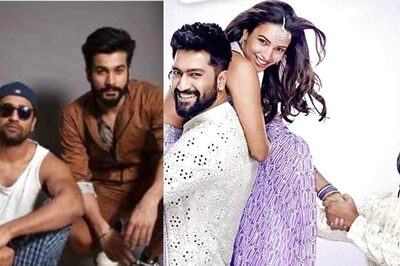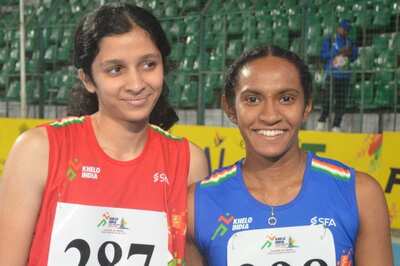
views
New Delhi: The National Anthem has assumed the centre-stage of a debate once again, with the Supreme Court being the reason this time as well.
A year ago, the arguments centred around why the top court should pass orders on playing the Anthem in movie halls and if this could encourage policing patriotism. And now with the Court reconsidering its orders, questions have arisen either on legal justification of the first order or on reasons for the Court’s sudden disposition.
Has the Supreme Court dragged the National Anthem into an unnecessary controversy?
It was a year ago when the Supreme Court had admitted a PIL on the National Anthem and called for the Central government's views. A month later, it issued seven directions on singing and playing of the Anthem while making it compulsory for all movie halls to play the Anthem with the National Flag waving on screen.
The highest court of the land then held that "a time has come (that) the citizens of the country must realize that they live in a nation and are duty bound to show respect to National Anthem which is the symbol of the Constitutional Patriotism and inherent national quality."
In December 2016, when a film festival organiser sought tweaking of this order on the ground that the event would involve foreign films and foreigners apart from a series of movies back-to-back, the Court observed: "If there are 40 movies running in different shows, you will have to, well, stand 40 times."
The Court order last year, in fact, renewed a debate over nationalism and manifestation of this sentiment, which had raged on after the JNU sedition row and the protests that triggered after killing of separatist militant leader Burhan Wani.
But the Court now has had a rethink over its November 30-order of 2016.
During a hearing last week, Chief Justice of India Dipak Misra, who heads the bench in this case, said that he is inclined to recall the mandatory direction to movie halls so as to leave them with a discretion to decide whether they want to play the Anthem or not.
Another judge on the bench, Justice DY Chandrachud went a step ahead as he questioned the very rationale of this order. The judge commented that not singing the National Anthem at a place of entertainment will not make someone anti-national. Justice Chandrachud was not on the bench which had passed the interim order last year.
The Court’s latest order has shifted the onus on the government, demanding a response whether the Centre would issue appropriate directions on the National Anthem, given the fact that it has supported the Court orders in this regard ever since the beginning of the case.
The observations made by the judges in the open court have now again ignited a debate on the anthem and its sanctity. Questions are being raised how, when and where it should be played. Also, on how should people conduct themselves?
So, did the Supreme Court by entertaining the PIL and issuing interim orders bring the National Anthem into a controversy completely avoidable? Are the comments now being made on its sacredness and value are not because of the top court’s interim order and the apparent re-think now?
When the matter was first taken up by the Supreme Court, it had sought the opinion of the Attorney General. After the law officer appeared and lent his support to the petition, the bench issued a seven-point stern order, saying: “The directions are issued, for love and respect for the motherland is reflected when one shows respect to the National Anthem as well as to the National Flag.”
The top court then cited Article 51A, which obligates all Indians with a fundamental duty to respect the National Anthem, to highlight that respecting the Anthem and other ideals engrafted in the Constitution is every citizen’s “sacred obligation”.
But these principles have now been questioned on the points of law, judicial precedents and constitutional limitations. Jurisdiction of the Court has also been questioned when there are specific legislations and various government notifications on this subject. Under the present legal regime, the Prevention of Insult to National Honour Act and the Flag Code occupy the subject area. The Court was also told that even the state governments had the authority to issue appropriate orders on playing of the Anthem and some of them, including Maharashtra did so.
During the hearing on October 23, Justice Chandrachud further pointed out the law is silent on ‘sitting’ or ‘standing’ while the Anthem is playing and that the government has not even bothered to change laws in this regard.
Not that these questions were not raised earlier or that the positions in law were not clear but the Supreme Court had still gone ahead and issued the contentious directives in 2016. In spite of the clamour against its order, the Court even took the call to stand by its directions and repelled attempts for modifications.
Why the re-think now? There is nothing new, either in law or in facts, which has been brought to the notice of the Court in the last hearing. But the CJI expressed his inclination to change the order.
Attorney General KK Venugopal was taken aback when he was apprised of the willingness by the bench to change its order. Apart from the necessity to inculcate sense of nationalism and cohesiveness through the Anthem, the AG had nothing more to say.
What transpired in the hearing last week has revived a debate again on nationalism, patriotism and jingoism. Unfortunately, the National Anthem, being the focal point, has not remained divorced from some petty bickering too. The squabbling over the National Anthem has the dangers of trivilaising its sanctity and the Supreme Court, through its flip-flop on the issue, has perhaps exposed it to this peril.




















Comments
0 comment